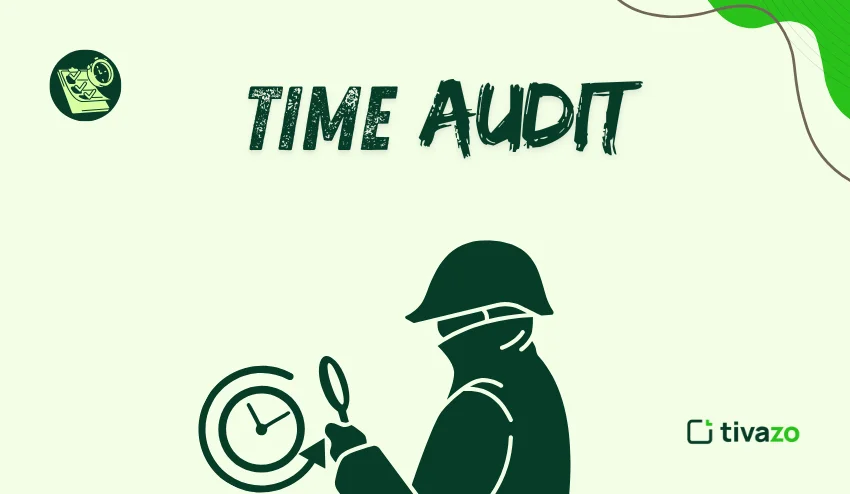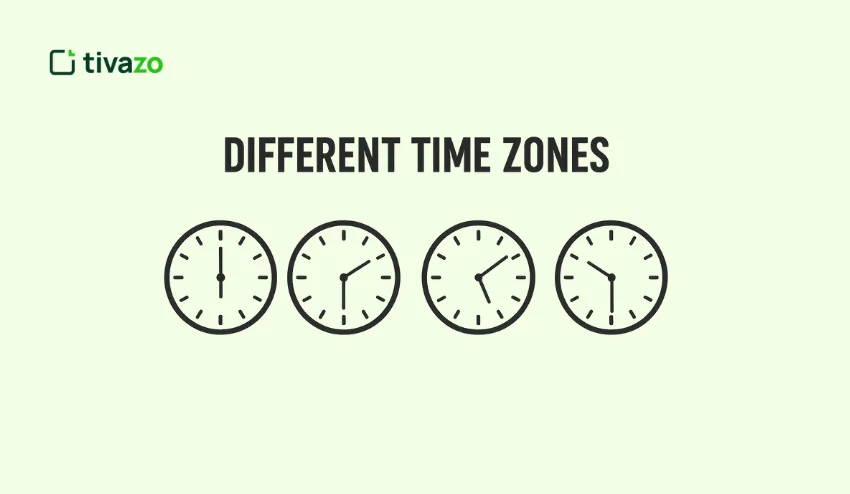A time audit is a structured activity that tracks, reviews, and analyzes how you use your time for a defined period. The objective is to see what you are actually spending time on – versus what you believe you are spending time on – and align your actions more closely with your priorities and the things you truly want to do.
A time audit consists of logging every activity you do (both work and often, personal), categorising those actions, capturing the time spent for each, and reviewing your outcomes for improvement areas.
When you conduct a time audit, you shine a light on the “hidden time drains” (unproductive meetings, switching context, email overload, unplanned breaks) and find time again for what matters.
Why a Time Audit Matters
A time audit is more than just an interesting productivity exercise; it’s a crucial prerequisite to better time management, better performance, and better choices about your time. First, here are some interesting reasons why time audit is important:
1. Reality Verification of Time versus Intention
You might plan to use hours working on some strategic deliverable or strategic work, but a time audit may reveal to you that you are spending far more of your time in reactive mode than strategic mode. This exposes the disparity between intention and reality.
2. Identification of Time Wasters & Hidden Tasks
When you’re not tracking your time, things like informal breaks, poorly structured meetings, or multi-tasking often go under the radar. A time audit causes these issues to be accounted for.
3. Better Focus on High-Value Actions
When you know how you are using your time, you can choose to eliminate low-value distractions and devote all of your time to actionable, high-value, productive work (strategy, growth, deep work).
4. Better Use & Scheduling of Time
In addition to identifying time wasters, auditing your time can tell you when you are most productive.
5. Base for Team/Organisational Efficiency
A time audit gives you visibility into how time is being used on a team level, where the pauses in time use occur, and how workflows can be streamlined or resources reassigned.
6. Greater Accountability and Decision-Making
When you conduct a time audit, you have the data to make a rational decision about meetings, resource allocation, task priority, and even staffing.
As time is a non-renewable resource, going through a time audit is to invest in productivity, clarity, and long-term sustainability.
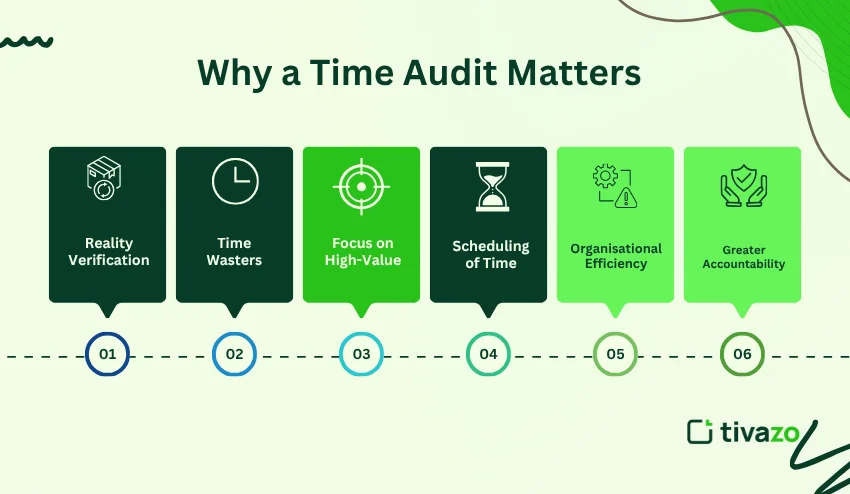
What Are the Benefits of a Time Audit?
Here is a table summarising the core benefits you can expect from conducting a time audit:
| Benefit | Description |
| Enhanced Awareness | Becoming actively aware of how you spend each hour, instead of being in autopilot mode. |
| Time Drain Removal | Recognizing and eliminating time drains, low-value tasks, distractions, and inefficient workflows |
| Enhanced Prioritisation | Spending more time on what matters (strategic tasks) and less on what doesn’t. |
| Enhanced Productivity | With clearer insight, you work smarter, not just harder, and get more done. |
| Improved Work-Life Balance | With knowledge of hidden time uses, there may be time reclaimed for personal, health, or downtime activities. |
| Data-Driven Decisions | Real data rather than estimations to schedule work, plan for the team, or identify workflow processes. |
| Scalable With Teams | For an organisation, a time audit can help create efficiencies in workflows, resource planning, and hold people accountable. |
If you keep asking yourself, “What will a time audit do for me?”, here are the relevant outputs you will see when you engage with the process.
What Are the 4 Categories of Audit?
Although “audit” is used in various ways, regarding audit in the business/process sense, there are four common specific types. Having an understanding of these positioning considerations will help you place your time audit within the larger audit environment.
- Financial Audit – an audit of an organization’s financial records, including its statements and compliance with accounting practices.
- Operational Audit – an audit of an organization’s processes, workflows, and operating efficiency.
- Compliance Audit – an audit to determine whether a business is compliant with laws, regulations, or internal policies.
- Performance Audit – an audit that challenges how well a program or process is meeting its stated goals and the extent to which it utilizes resources effectively.
From a time audit perspective, you are composing a hybrid of operational + performance. You are auditing the operational time utilized and the performance results in achieving the stated goals. This is not about compliance or financial issues; it is about productivity and alignment with Organizational goals.
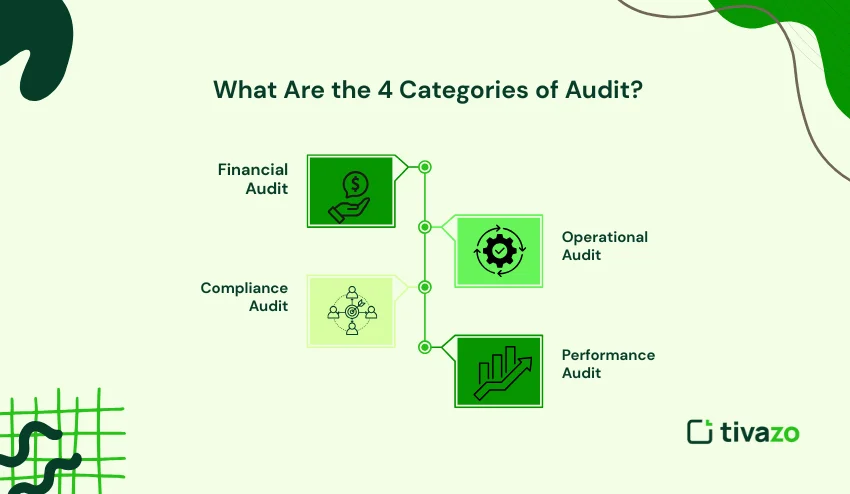
What are the 5 steps to do a time audit?
Breaking down a time audit into 3 phases, especially if you want it to lead to actions and improvements, can help! The 3 phases are:
Step 1: Track Your Time
This means capturing everything you do during the time period you choose for your audit! This includes: tasks; meetings; admin; breaks; interruptions; and moves from one task to another. You can use whatever method you would like (manual, a spreadsheet, a timer app, etc.), but the important part is to capture reliable data.
Step 2: Categorize and Analyze
Now that you have data, categorize it by groups (for example: strategic, tactical, admin, waste/distraction). Analyze the data to see patterns of where you are spending your time; what percentage of your time is productive time; and how much of your time is reactive time?
Step 3: Act and Adjust
Based on what you see in the data, look at it for insight and make an action plan, including which tasks to prioritize, which to delegate or jettison, and what you might adjust in terms of structure to your day or schedule. Include this plan in your follow-through. Simply doing a time audit is not helpful unless you perform actions based on it!
These 3 steps are a scaffold: track→analyze→act! Even more description can help, but these steps are what make up the bones of the full process.
Step 4: Review, Categorize & Visualize
At the end of your audit period, aggregate your time by category.
Ask yourself: Which categories of tasks took up the most time? Which categories were misaligned with my goals?
Then create some type of graphical visual (pie charts, bar graphs) to help collate and clarify your categorization. Many tracking tools help associate your activities with visual aids.
Look for patterns as well: i.e., “Email takes up 25% of my day,” “Unscheduled interruptions happen often,” “High value tasks are squeezed in.”
Step 5: Take action and monitor change
With a clear categorization of your time audit in mind, begin to change your schedule/workflow:
- Space blocks of time for deep work when you have peak energy.
- Reduce/delegate administrative or other similar tasks to allow for deeper focus.
- Establish boundaries to constrain meetings and interruptions.
- Use scheduling tools or automation to reduce context/mode-switching.
Then monitor over your next audit period: did you get near your desired use of time? Use the mini time audit again to help compare.
By repeating the 5-step process over time/periodically, you will enable a habit of evaluation and adjustment, which maintains a focus on continuous improvement.
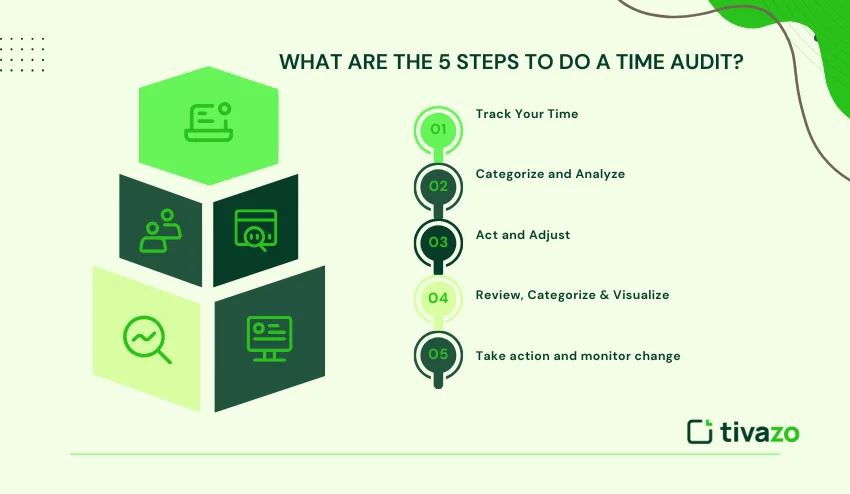
Valuable Perspectives Regarding Time Audit
Here are helpful thoughts from professionals to further support your time audit effort:
- Use Color-Coding for Quick Insights: One professional noted that color-coding the blocks on your calendar gives you an immediate visual representation of where you are spending time to quickly address inequity.
- Automated Tools Provide Precision: Many experts posit that tracking software is valuable for capturing passive time (such as usage of applications or idleness), which would be missed on manual logs.
- Don’t Have “Audit Paralysis“: One caveat don’t make the audit itself so laborious that it detracts from energy and time. Track time for a manageable length of time, analyze that time, act on it, and move on.
- Team Time Audits can Help Identify Workflow Problems: Audits in an organization can illuminate step problems (such as pending approvals, meetings that are not necessary) and keep track of workflow with team members.
- Make Link Time Use to Outcomes: The best audits correlate your hours with certain outcomes (such as revenue generated, milestones for specific projects, ROI), rather than just simple hour tracking.
- Regular Time Audits Promote Habit Building: Experts recommend performing time audits routinely (quarterly or twice a year), moving from insight as an activity that becomes habitual rather than a one-time deal.
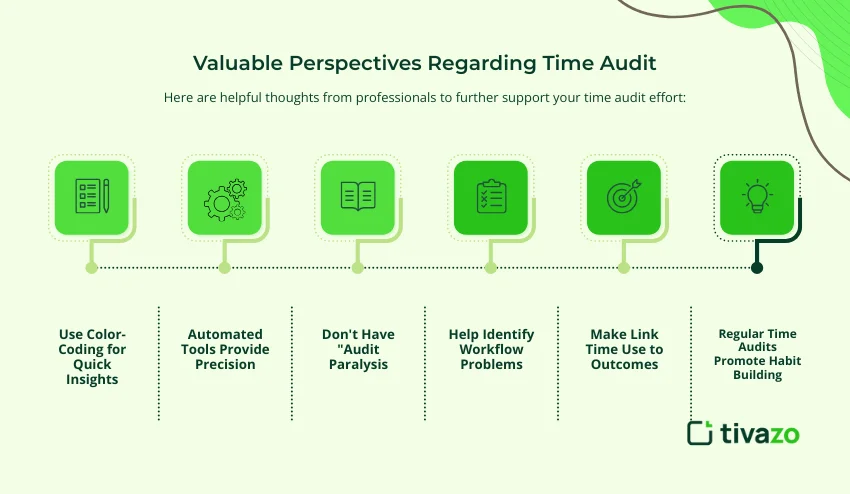
Practical Tips & Best Practices
- Keep track of everything, including what you might consider a trivial task (like looking at your phone), even the smallest of tasks add up.
- Document a “typical” week, preferably to an outlier week, one that included rare events.
- Keep categories the same throughout all tracking cycles and over time so you can compare.
- Assure the start and end times are correct without any rounding.
- Avoid having any odd tasks occur during the audit; normal workflows will give you better data.
- Don’t simply reflect on the results of the audit, but rather take action from the audit results. Either block time, schedule on purpose, delegate, or even delete tasks that you see no value of these tasks.
- If you are conducting a team audit, make the process anonymous and transparent. The goal is insights, not blame.
- Share your insights and “plan of action” with your team or leader, as this will increase your accountability and follow-through.
- Consider doing a baseline and follow-up audit (for example, track, change, track again in 3 months) to assess improvement.
- Celebrate changes: if low-value tasks have decreased, and high-value tasks have increased, celebrate your progress!
Conclusion
A time study is a valuable first step for anyone wanting to regain authority over their time, increase productivity, and align their hours spent with their priorities. By recording, reviewing, and acting on your time use, you will develop clarity, decrease waste, and focus on what drives outcomes.
Whether you are reviewing your own individual productivity or facilitating a team, a time study looks the same: set goals, record precisely, categorize & analyze, act decisively, repeat.
The key is – you can’t manage what you don’t measure. Start your time study today. Your hours can serve as strategic assets, instead of an unmanageable mess in your calendar.
